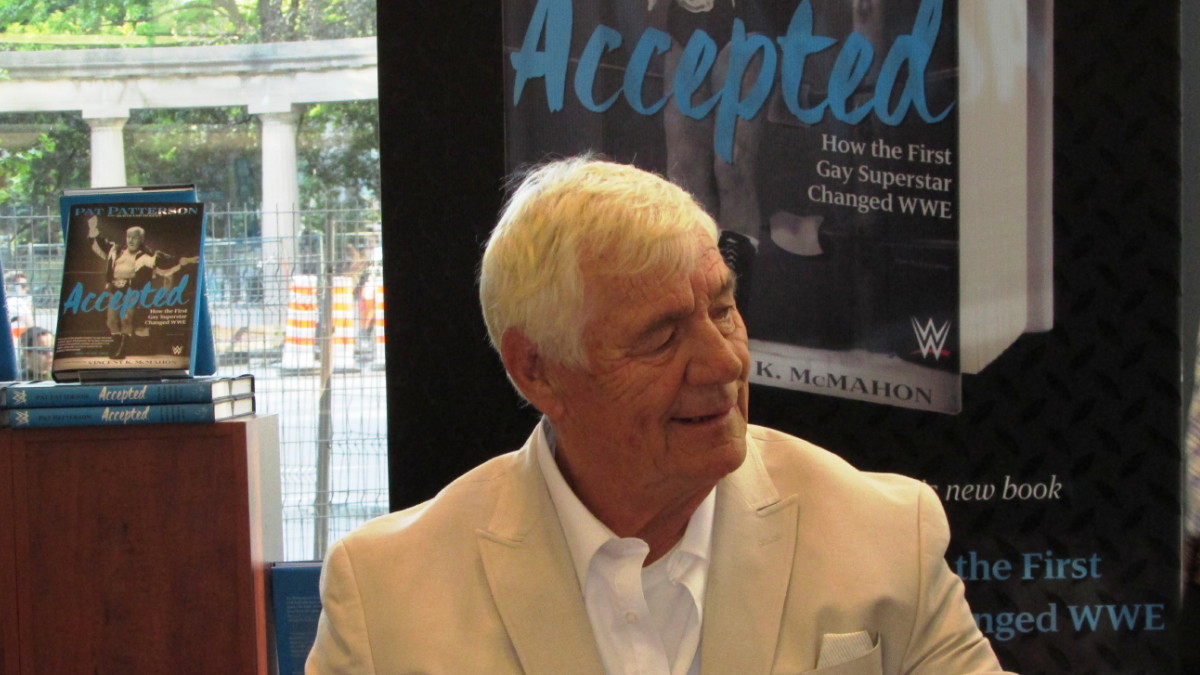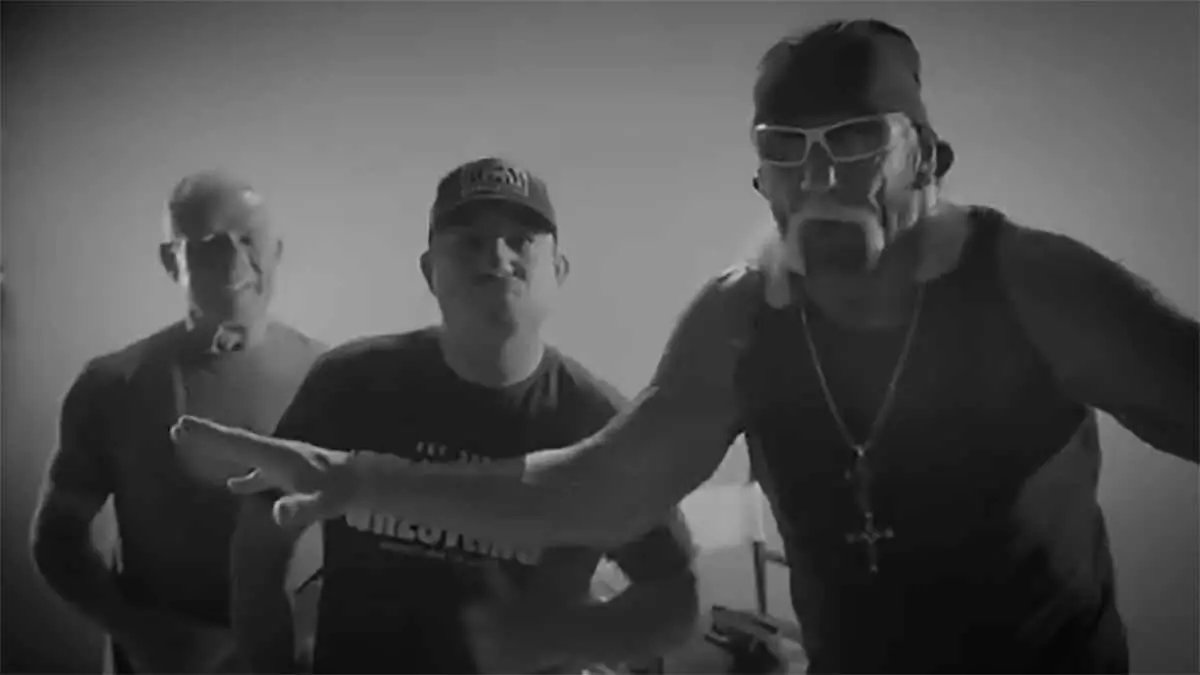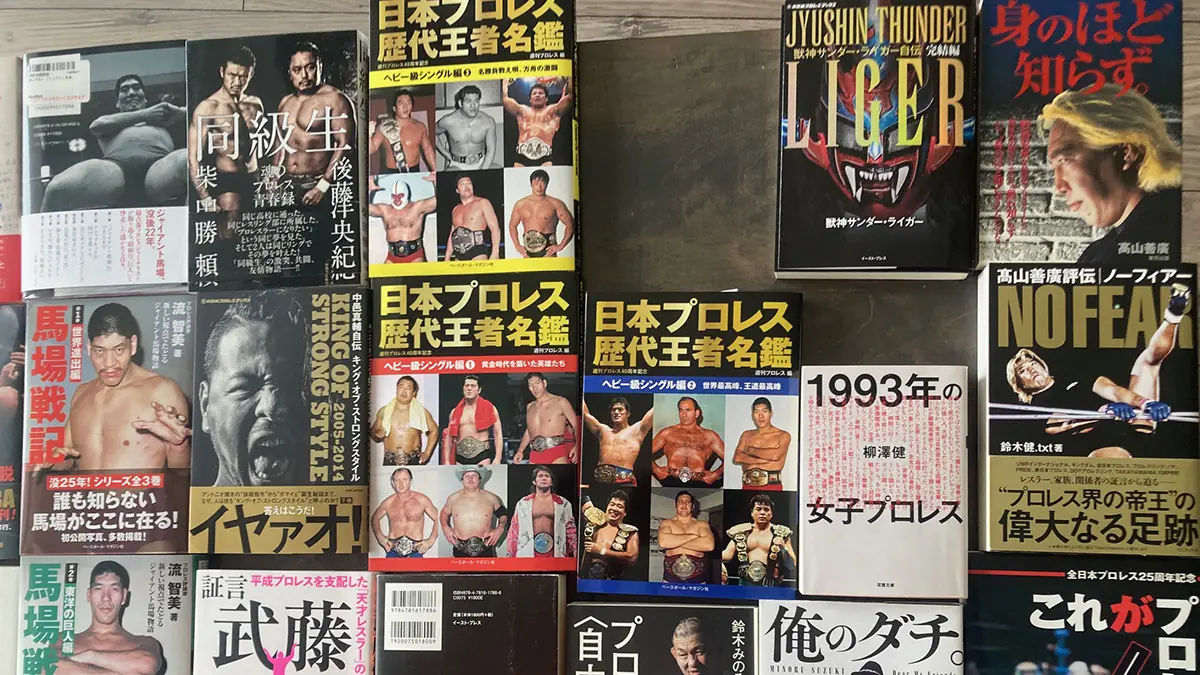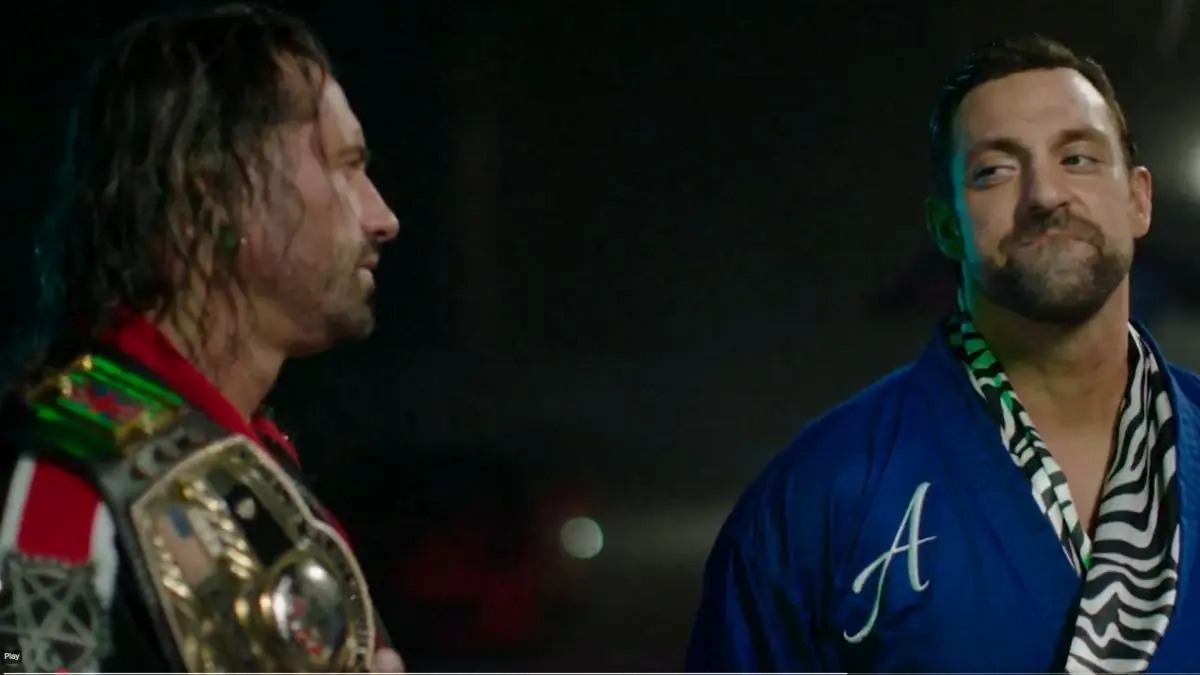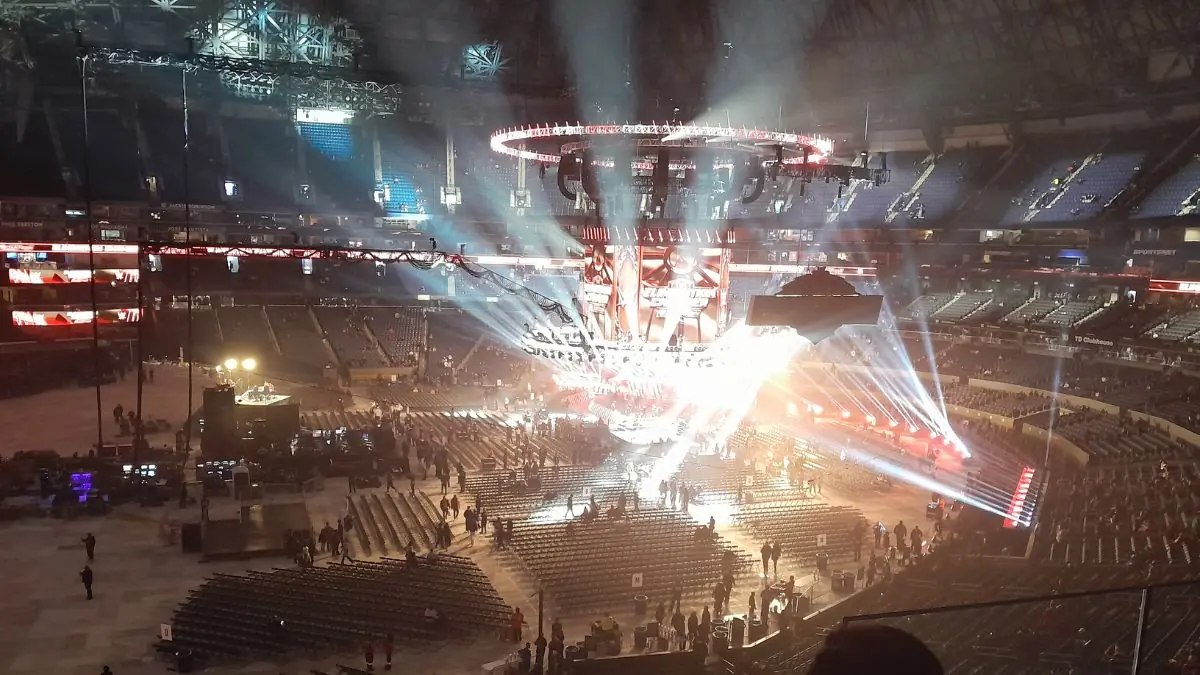Being gay in professional wrestling has never been an easy thing. As I think back to the life of Pat Patterson, who died December 2, 2020, it makes me wonder what sort of challenges he had to face during his career that went all the way back to the late 1950s.
For those of you who weren’t a part of the wrestling business years ago, you will never know the sense of constant fear one felt as a gay man – we were a long way away from a world that embraces performers like Sonny Kiss. You were seen as “less than a man,” and people who knew and respected you had a different set of rules for you if they even suspected you were gay. Effeminate characters became comedy figures, like Ricki Starr, who incorporated ballet into his shtick, or focal points of all-out rancor, like Gorgeous George, who played the audience like a fiddle with his prissy, self-absorbed ways and his sense of outrageous grandeur. All the flamboyant physicality, conceit and spectacle that we have come to embrace in performers like “Nature Boy” Ric Flair actually has its roots in alluding to homosexuality, to incite anger. Men like the original “Nature Boy” Buddy Rogers, the Graham Brothers and the Fabulous Fargos all used this iconography, mindfully, to get a reaction and make more money. Not showing overt masculinity in the rough and tumble world of professional wrestling, it made the fans want you obliterated.
When I was working the independent scene in the late 1990s, I was very close to promoter Roland Alexander, who would listen to a few of my ideas because he knew I understood the business. We were about to do a show at a high school where a very violent homophobic attack just had taken place: Several students beat up a young gay student and carved the word “Fag” into his chest with a knife. We had a wrestler on our roster who played an over-the-top gay character, all for the sake of pissing people off. I knew in my heart it would be a mistake using him at the high school show, so I brought my concerns to Alexander. He listened to me, and he said he understood where I was coming from, but he said he was still using that character because he got heat.
Professional wrestling has always had its own set of rules. You learn to accept them or you leave the business. Things that would be highly unacceptable in most lines of work are commonplace in wrestling. That isn’t to say that makes things right, or that you become comfortable with certain aspects of the business, you just suck it up and keep going. As it has always been said, “That’s wrestling.”
Pierre Clermont left his home in Montreal, Canada in 1958 to try and make something of himself. His family was dirt poor, so he was never going to get any real support from them. And his background as a Roman Catholic furthered his insecurities, as he knew early on he was a homosexual. He luckily found his calling in professional wrestling and changed his name to Pat Patterson, then went to take on the world.
In the early days, he was instructed to play up his homosexuality for heat, wearing a pink jacket, lipstick and a French beret, calling himself “Pretty Boy” Pat Patterson – a dangerous proposition, for sure, since people wanted to attack you for being gay, and you had to be ready for anything. This almost seems like a death sentence to the modern mindset, or a horrible rib perpetrated by a homophobic promoter. But that’s just how things were back then, and Patterson was sturdy enough for the assignment. He learned fast and gained the respect and admiration of wrestlers and fans alike.

In the mid-1980s, Ed Leslie became the arrogant Chippendales dancer-inspired Brutus Beefcake in the World Wrestling Federation. He was announced as being from San Francisco, California, and in certain markets around the United States that gained an immediate negative reaction (which was absolutely intentional). If you ever lived in the Bay Area (as I did), you know it’s not as liberal as many people believe it to be – it’s about half liberal, half deeply conservative. There is a misconception from outsiders that Patterson got over in San Francisco because he was gay and that gays are totally embraced in the Bay Area. But look at what happened during the time of Harvey Milk, when Patterson was active in the territory, as evidence of the tensions that actually existed. The truth is Patterson got over because he was one of the greatest talents of his generation, and his being gay could be viewed as more of a detriment than a positive.
That’s not to say that Patterson didn’t have a following amongst the gay community. People knew, but it was talked about in whispers. Back then, everything existed in a world of subtle communication and coded wording. Pat had a following amongst the gay community, for sure, but he could never address it directly on television. It has always been said that Patterson’s homosexuality was the worst kept secret in wrestling. To his credit, Patterson never tried to “butch it up” to disguise the truth – he was who he was, and he let you draw your own conclusions.
True talent cannot be denied. Patterson was a major draw everywhere he went, be it across North America or internationally. Being the star that he was, Patterson never saw the need to alter his presentation at all, as many gay men of the era felt obliged to do for the sake of career security as well as physical safety. What you saw was what you got – all that really mattered was how he could perform in the ring. As a wrestler and entertainer, Patterson was flawless.
Everybody gets ribbed in wrestling – It is a part of the culture. Backstage, they will make fun of you for having ugly ring gear, putting on too much weight, having a bad match, what have you. It’s very much a frat boy/locker room mentality. The trick is not to play into it and learn to laugh it off, because if you don’t then the boys will find your weakness and go after you. So if you’re given a bad gimmick, you learn to own it and do the best you can with it. If somebody pulls a rib on you, you don’t retaliate or get angry because it will only escalate – you learn to laugh it off or just ignore it completely.
It was a different time, and gay men did anything they could just to survive in a world that offered them very little support. Patterson employed the classic tactic used to deflect bullies: He learned to laugh at himself. If you point out your own foibles and make yourself the butt of your own jokes, you are no longer at a point of weakness and insecurity. He would make gay jokes before anybody would say anything, and he learned to take it all in stride. It made some wrestlers uncomfortable to see him so confident as a gay man, as they were used to seeing gay people fearful or marginalized by our culture. But Patterson was never going to be a shrinking violet, not for anybody.
When Patterson inadvertently walked in on ladies wrestler Velvet McIntyre, who was stark naked, Patterson laughed and said, “Vel, get over it. You know I’m one of the girls.”
As you may surmise, everybody made fun of Patterson for being gay. You could always use Patterson as a convenient punchline to a joke. Right or wrong, that’s how it was, and I’m talking industry-wide. It’s like using Liberace as cannon fodder – he was the universally accepted target. And, like Liberace, Patterson went crying all the way to the bank.

Gay people were constantly made fun of, not only backstage, but openly on television. Gorilla Monsoon used to mention during his commentary that wrestlers with little ability were graduates of the Terry Garvin School of Self-Defense. That wasn’t because Garvin was a bad worker (because he wasn’t) or because he wasn’t respected (because he was) – It was a jab at Garvin for being gay, alluding to the old stereotype that homosexuals are somehow weaker for being attracted to other men. And Garvin was an employee of the company!
Then there was “Adorable” Adrian Adonis, a character that existed purely to anger people because he was supposedly gay. He was a total cartoon, playing on all the fears and misconceptions that people had about gay people. There was certainly no subtlety involved here, with Adonis wrestling in a dress, carrying flowers and wearing a big, floppy sun hat. Rather than being attractive (as he claimed to be), he looked more like a trucker that morphed into an obese housewife with no sense of style. When he would be wrestling, people would scream out, “Kill that faggot!”
Wrestling has always used homophobia to rile up the crowds. Think of Gorgeous George, the prototype for all gay gimmicks, with his bleach-blonde hair, flowing robes and flamboyant ways. Think of Jim Cornette playing the young “sissy” in Mid-South Wrestling to get heat – literally, people wanted to kill him, and he had to fight for his life every night. Or think of “Exotic” Adrian Street, who would skip around the ring, kiss his opponents and dress like a Mardi Gras float – if he wasn’t one of the toughest men in the business, he would have had some serious issues over the years.
Goldust came along in the mid-1990s as a more modern take on homosexuality, but the character was still designed to enrage fans through the device of homophobia and sexual ambiguity. In the early 2000s, when WWE appeared to be at its most progressive with the subject, it gained a great deal of media attention with the “wedding” of Billy Gunn and Chuck Palumbo. Their gimmick played on all the typical stereotypes you might imagine, and even though the participants swore it was real, it only turned out to be a storyline.
We still live in a world that is coming to terms with gay people being seen as normal, with them living happy, productive lives. A lot of the heat that Patterson got was from him being comfortable and fearless in who he was, and then becoming a man of power and influence. For those who were accustomed to homosexuals living in the closet and accepting a marginal role in society, Patterson’s success was like pouring gasoline on all their insecurities.

If a wrestler wasn’t a success, or didn’t get the push they felt they deserved, it was easy to simply blame Patterson for their woes. Typically, they would claim that they never rose up the ranks because Patterson wasn’t attracted to them, or that they rebuffed his advances. It almost seems comical now, but there are those out there who genuinely believe this to be true. Never did these wrestlers take into accountability their own lack of talent or ability to get over with an audience – it was always easier to blame Patterson.
Men like Al Perez simply walked away when hearing Patterson talk about their future with the WWF. Patterson explained how Perez could make a lot of money, that they could use him “both ways,” which Perez took as a sexual comment. Patterson adamantly said it was inferring they could use him as a good guy or bad guy. Whether these accusations hold any water is something we might never know. Fact is, many people would look for hidden agendas in Patterson’s words and actions, whether it was justified or not, simply based on his sexuality.
If there were any rumors based on homosexual activity – even if it was a rib – everybody immediately pointed to Patterson. And even though some of these ideas existed merely as conjecture and speculation, there are many that hold on to these notions today as fact. And the more these things are stated, the more people are inclined to believe in them.
When the WWF ring boy scandals made national news in the early 1990s, Patterson was lumped in with the perpetrators. Fact of the matter is certain individuals were terminated (Mel Phillips and Terry Garvin) and Pat continued working for the company.
Bertrand Hébert, who worked with Patterson on Accepted: How the First Gay Superstar Changed WWE, and knows more about the man than anybody in the world, pointed out that it was rumor and innuendo concocted by “Superstar” Billy Graham that created all of these ongoing issues for Pat. “It was all lies by Graham that started this,” said Hébert. “In the book we explained how an outside investigation ultimately cleared him of any wrong-doings, and that’s why he was brought back.”
Around the same time this scandal came about, Murray Hodgson, who worked briefly for the WWF as an announcer, started publicly accusing Pat Patterson of sexual harassment, claiming he was fired for rebuffing his advances. Hodgson shamed and embarrassed Patterson, who was still publicly in the closet, and figured his repeated threats through major media outlets would get him anything he wanted. The WWF stood behind Patterson, with Pat leaving his position for a period of time to collect himself from the hurtful experience. Once the investigation was complete, McMahon welcomed Patterson back to the company.
Jim Cornette, who worked closely with Pat for several years and knows the business better than almost anybody, recently stated on his podcast how he felt about all these accusations. “It’s bullshit. And the only reason – the only single reason – that Pat Patterson got caught up in that controversy was because he was the other gay guy. That’s it.”
People will never stop talking about these things simply because they are scandalous, and a cloud born from these sordid thoughts will always hang above the legacy of Pat Patterson. Scandal sells and it’s just human nature to be drawn to it. Many of Pat’s most ardent accusers, like Barry Orton, later recanted. Even Billy Graham, who was the start of all these problems, said recently, “As most of you know I said some very harsh untruths about him on the old Phil Donahue show. Vince told me that he forgave me for those lies but Patterson would never. And Vince was correct.”
As Jim Cornette also explained, “Everybody that’s accused Pat Patterson of doing wrong shit and misusing his position and abusing people or anything else, that’s the worst kind of homophobia because you’re just assuming because he was gay he was involved in it, too.”
Not that long ago, you could be fired for being gay. Being outed in the media could destroy your entire career. Up until the early 1970s homosexuality was considered a mental disorder, and the World Health Organization listed it as a disease until the early 1990s. To a great extent these fear-based beliefs still exist today. To my eye, Murray Hodgson was trying to not only assassinate the character of Pat Patterson, but publicly humiliate him and take away his livelihood. And if Pat didn’t have the support and resources of the WWF, given the time period and the mindset the general populace here in the United States, Hodgson could have easily gotten away with it.
When wrestlers talk openly about their past exploits of drugs, sex and debauchery, they say “that’s just how it was back then,” that “boys will be boys.” Again, wrestling has always had its own set of rules. What Patterson did in his day was no better nor no worse than what any of those wrestlers did. However, just because he was a gay man, he was painted with a different brush by certain people, and Patterson was seen to have no morality or redeeming qualities. It makes no sense at all. Almost every wrestler out there will confess to temptations of the road, admitting that that’s the way things were back then. Holding together a relationship of any kind is nearly impossible in this realm, yet Patterson and his partner, Louie Dondero, stayed together for 40 years – that speaks volumes.
But for those within the industry who know better, Patterson can be accurately viewed for what he was: a wrestling genius. He knew how to orchestrate professional wrestling on every single front, helping create the template for the WWF and everything it would become. As a wrestler, he was one of the greatest of all time.
To his peers, he had long been out of the closet, but Patterson acknowledged it publicly on WWE Legends House in 2014. Through tears, Patterson talked about how much he missed Dondero (who died in 1998), and how hard it was making it in professional wrestling as a gay man. It was clear that it was a relief to say these things openly, without any shame, and he reclaimed a little part of himself at that moment.
Patterson had a gregarious personality, a sly sense of humor and intoxicating character. He was literally the coolest guy in the room and everybody flocked to him. Patterson was comfortable in his own skin and genuinely loved life. And if he was near a microphone, no one could stop him from belting out “My Way,” which more or less served as his anthem.

I wrote this because Patterson was a man of great character and courage. He deserves to be remembered for the goodness he brought to the world, not to have his reputation disparaged by ignorance and innuendo. Patterson was a friend and mentor to countless people over the years, all of whom will vouch for his value as a human being and as a talent. As somebody who grew up in the Bay Area, where he is still revered to this day, I can honestly say it’s nice to have your heroes turn out to be the real deal.
And anybody from the LGBTQ community in professional wrestling owes Pat a huge debt of gratitude. He may not technically be the first openly gay wrestling superstar, as the press releases would lead you to believe, but he’s the closest thing we ever had. He paved the way for so many people, it can’t even be measured. Men like Pat made this a safer, better and more open-minded world for all of us within the community, affording us opportunities and levels of acceptance that would have previously been denied us.
For those who knew Patterson and know the truth, he wasn’t ostracized for what he supposedly wasn’t, he was embraced for what he actually was. And that’s exactly as it should be.
TOP PHOTO: Pat Patterson at his book launch for Accepted in Montreal in August 2016. Photo by Mike Wyman.
EDITOR’S NOTE: This article was amended after publication to clarify the WWE sex scandals with Terry Garvin and Mel Phillips, and a quote from Patterson biographer Bertrand Hebert added.
RELATED LINKS
